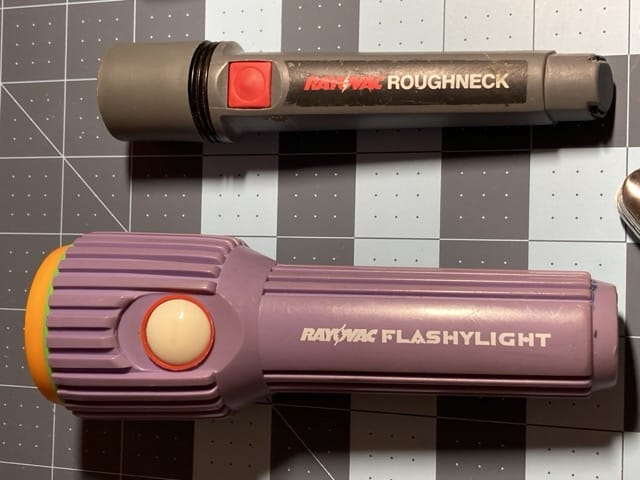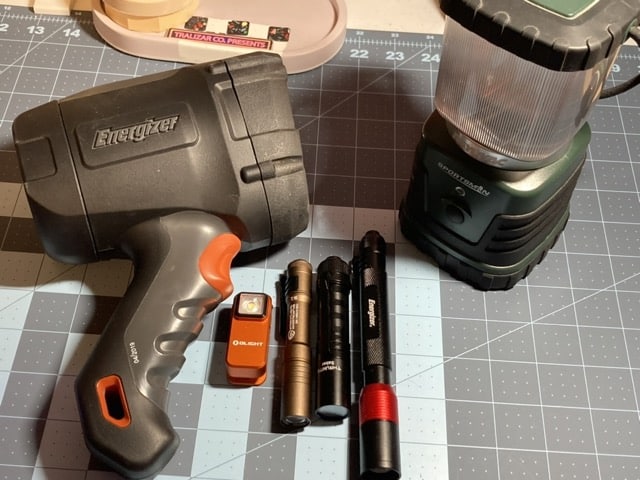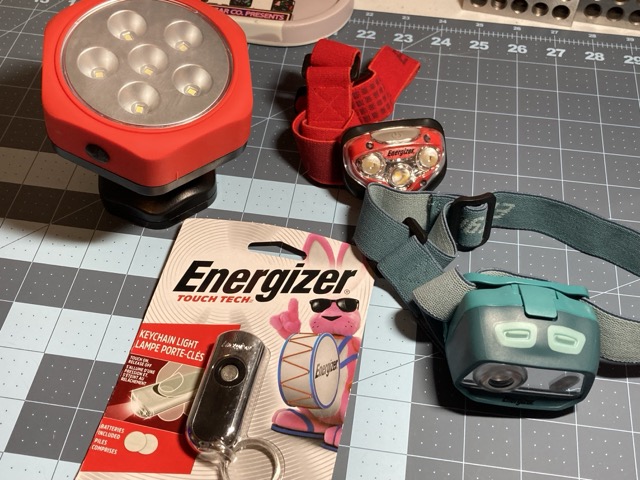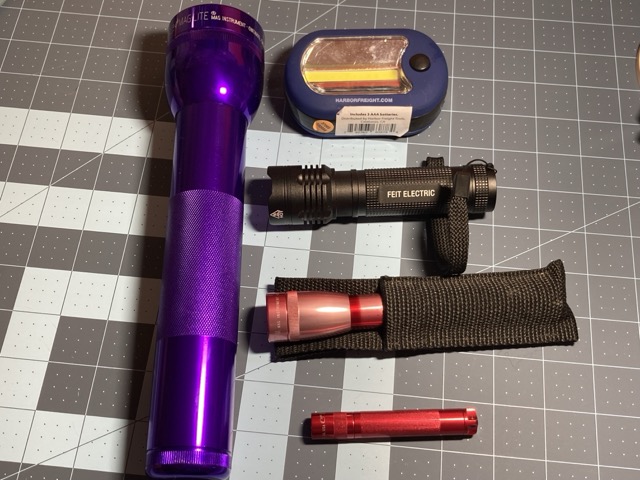My love affair with flashlights began early enough in life that I remember using one to read under the covers of my bed at my parents’ first house, which they sold when I was five.* Several times as a kid I was gifted reading lamps with clips that attached to books, a thoughtful concept that was clunky in execution for all but the slowest readers. I always returned to flashlights, which were more comfortable, versatile and stylish — so stylish that Rayovac named one of my favorites the Flashylight.

The Flashylight was like a Workhorse for children — and I had a Workhorse, too, that I must’ve misplaced since I couldn’t find it for this photo. Mine was small and rectangular and held up to regular use for 15 or 20 years, just like the junior Roughneck, which was a gift from my grandparents. All three of those lines were marketed together in the late ’80s and Rayovac was the nicest brand in my price range when I ogled flashlights at Kmart and Venture and showed my mom the ones I pined for.
My mom was another reason I wanted my own flashlights: she always bought the biggest, cheapest one she could find, then emptied its battery compartment when Felix or Tom needed juice for their toys. That meant we often lacked a reliable flashlight on the occasions one would’ve been useful, which was a familiar theme at home and at my parents’ business. Many of the things they found most perplexing about my habits, temperament and values — like a preference for long-term security over fleeting comforts — are direct, and occasionally unhealthy, responses to my upbringing. My siblings are more like them, which allows them to chalk it up to “Eh, Cranky’s just weird” without much additional thought.

The Rayovac Sportsman is a 300 lumens lantern that I got in 2010 and still use nightly. It’s underpowered by current standards but I was pleased enough with its reliability and features (three modes, plus a beacon so you can find it in the dark) to buy a couple more from a liquidator once this model was discontinued. We purchased the 600 lumens black-and-orange Energizer spotlight five years ago for tracking Muriel as she romped through our old backyard; now it’s my go-to for dark garages, sheds, and attics because it’s bright and close to indestructible. (That model’s been retired but there’s a new one in black and yellow that’s 800 lumens on its highest setting.)
I’ve been slow to add rechargeable flashlights to my collection because I’m not sure the premium you pay for the technology is worth it for general use purposes. But all four of those smaller lights are rechargeable: an Olight Oclip with a maximum intensity of 300 lumens; a Streamlight 66608 MicroStream that reaches 250 lumens; a 659 lumens ThruNite Saber, which can also be powered (at a lesser output) by a regular AA battery; and a cheap 400 lumens Energizer pen light. The Streamlight’s impressed me the most so far, followed by the Energizer, a solid performer that’s too bulky to neatly fit into your pants pocket (or in a pouch organizer), so I keep mine clipped to a small bag I carry on walks.**

“You’ve never looked more autistic than you do right now,” Crankenstein affectionately teased the first time she saw me in a headlamp. We’d been hassled by friends and family to make a wedding gift registry and didn’t want to impose by asking for expensive items, but a $15 multi-mode Energizer headlamp made the practical-and-inexpensive cut.* I’ve used it almost weekly for the last seven years but recently got a newer, brighter model for Crankenstein’s car emergency kit when it was on sale for $14.
The Touch Tech, meanwhile, is a possible replacement for the older, smaller keychain light whose death I recently lamented here, but it has fewer functions and is larger than I prefer. That red and black work light is a Harbor Freight staple — many hardware stores sell their own version — and I’ve grabbed a couple when they’re on sale for $3 or $4. They’re reasonably bright, the head rotates, and they have magnetic backers, so they’re handy in garage and basement settings; I keep one on the laundry room fridge and another on a utility room cabinet for convenience during power outages.

My third-stringers are mostly old Maglites from the early aughts; I have a couple more of the big boys packed away without batteries. The brand’s heft is part of its appeal, particularly in a situation where you might want something for self-defense, but they’re energy hogs that I only keep as backups. (When it comes to self-defense, you have to know your limitations and plan accordingly. Unless I’m mugged by a preschooler, I’m not scaring anyone off with a heavy flashlight.) The Feit and Harbor Freight lights are fine for stashing in glove boxes or dark closets; the Harbor Freight’s hook and magnet make it surprisingly useful, which is why it’s the store’s most popular freebie during special promotions.
Wasn’t that gripping? Would anyone like a sequel with my collection of multitools and photos of our various emergency and disaster preparedness kits? A treatise on why the scissors from a $10 Swiss Army knife are superior to the Leatherman Micra’s scissors (even though the Micra’s a timeless classic in its own right)? My reasoning for keeping thermal blankets and disposable ponchos in our glove boxes? The answer is probably ‘no,’ but you’ll feel differently once you see the morale patch on the pouch I keep in my backpack.
* I was a voracious reader from the age of three onward, which sometimes created odd situations at school. In first grade, the teacher gave each of us a book for Christmas. Mine was a novella about junior high students, complete with chapters, while my classmates got children’s books.
** The Oclip’s a cute novelty with a nifty magnetic clip but the ThruNite overheats quickly, which makes me a bit nervous. I wouldn’t pay full price for any of the rechargeables but recommend the Energizer or Streamlight if you need a pen light and can get them on sale.
^ Crankenstein’s most whimsical mentor threatened to go rogue and buy us something impractical if we didn’t include higher price points, so we added an Instant Pot and a Kitchen-Aid stand mixer. I’m often intrigued by what makes it onto wedding registries. Crankenstein’s best friend from high school had a list similar to ours — $10 bath towels from Target, a $15 battery charger — while her colleagues from wealthier families asked for $500 espresso makers and contributions toward lavish honeymoons. Our wedding invitations included a note that gifts weren’t expected, specifically because we knew some relatives couldn’t afford it. Even if they were rolling in dough, we wouldn’t have felt entitled to expensive gifts.